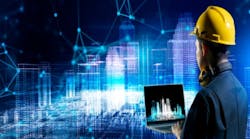Building-automation systems enabling wins at the edge of the edge
The workforce has changed. The workplace has changed. And demands from workers, customers and manufacturers are changing, too.
Building-automation systems (BAS)—including traditional access control systems (ACS) and video-management software (VMS)—are the edge-based frontline systems that users are looking at to implement and manage these new demands, says John Vicente, CTO of Stratus Technologies.
Modern BAS is a starting point to manage the local demands for social distancing, contact tracing and response coordination, which can be tracked from new devices like thermal cameras.
It’s here that edge computing comes into play, he believes. “Enhanced edge-based infrastructure and associated compute solutions are the only effective way to deploy and manage these new technologies in a cost-effective, timely and efficient manner.”
John stresses that building managers need to be able to accommodate these changing demands brought on by the COVID-19 pandemic, and the only way to do so is to integrate edge technologies into their overall digital-transformation strategies.
We wanted to learn more, so we connected with John. Take a look…
Smart Industry: How is the pandemic and resulting changes to the workforce/workplace affecting localized computing power?
John: A fundamental result of the pandemic has unexpectedly continued (if not fully extended) the trajectory of mobile computing. In this case, where computing's physical location and its proximity to where “work” is conducted becomes fully decentralized. This has broad implications not only on computing infrastructure, but the design of application services, operations, business-continuity services, and the dependence on outsourced services. The percentage of remote work will continue to shift as companies evaluate and change their dependencies on physical buildings and the evolution of collaboration utilities. In all of these scenarios, there will be a greater need for both local compute and remote compute to support alternative (hybrid) usages to where employees work.
Smart Industry: What technologies are we talking about under the "localized computing power" banner?
John: The technologies that will come to serve greater value on endpoint (PC or desktop) level include graphical (GPU) computing in the case of cloud-based or virtual desktop computing, 5G connectivity at the device, and greater computing capabilities and robustness (e.g., Intel vPro) typically seen in enterprise-class PC devices at home.
On an infrastructure level will be new requirements to support hybrid forms of work computing either via outsourced cloud back-office/ERP or on-premises back-office. In the latter case, the traditional DMZ or enterprise edge will likely expand in computing scale and traffic volume, meaning an increased demand for edge services typically seen from the vantage point of "work from home."
Thus, there will be greater computing capabilities needed for edge security (e.g., encryption, policy-based, IDS) technologies, edge-based high-availability solutions for business continuity, analytics for personalization and security, media-based collaboration, storage management and distribution, and finally, capabilities to support remote management or service automation.
Smart Industry: How are operators changing their approach to access control and video-management software during this challenging period? Will these approaches persist post-pandemic?
John: A clear value proposition for operators that has emerged during this pandemic has been the need for remote capabilities to enable independence from locally manned operations, supporting contactless tracing or tracking and (more broadly) remote security operations. Moreover, an increasing range of intelligence is being afforded through video analytics, acceleration technologies for faster analytics, and the growing instrumentation of sensors for access control and monitoring. Localized or edge fault-tolerance systems will certainly serve high value in maintaining continuity to local systems.
It will absolutely be a persistent shift even post-pandemic, as many of these (vision, fault-tolerance) technologies not only reduce costs, but advance toward more autonomous capabilities, not unlike how the vision of safety systems is paramount to autonomous driving.
Smart Industry: How do modern building-automation systems ease the management of these new workplace requirements?
John: BAS' future is one where dependence on human-operated functions is either remotely managed or just autonomously managed. Sensors (video, acoustic, machine or discrete) will be pervasive in buildings along with a wide range of analytics applications to support managing the building for efficiency reasons, security or to manage occupants (high variations) for collaboration, comfort, mobility or access.
Smart Industry: And how does edge computing enable the supercharged BAS?
John: Edge computing will play a greater role in supercharging BAS, as will cloud-based computing. In both cases, there will be a need for local computing to support local usages and or cloud-based usages. As discussed above, the local BAS-computing requirements will certainly increase to support the range from a wide variety of sensors, including advanced video and acoustics, real-time analytics and AI along with acceleration technologies, security and management technologies for both local or remote usages, and a range of connectivity options including Wi-Fi 6, 5G and Ethernet-APL, just to name a few.



